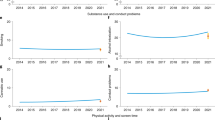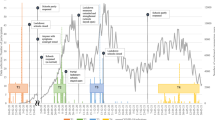Abstract
Research indicates that the COVID-19 pandemic has had adverse effects on adolescent psychosocial well-being, but little is known as to whether these changes persisted after pandemic-related restrictions were lifted. Addressing this issue, we examined whether declines in well-being remained after the pandemic and whether adverse changes during and after the pandemic varied according to parental socioeconomic status and adolescents’ sex and age. We used data from more than 500,000 Norwegian adolescents, assessed annually between 2014 and 2022. Multilevel analyses showed that after Norway lifted all restrictions, adolescents reported lower satisfaction with peer relationships and less-optimistic future life expectations, but less loneliness compared with long-term trends. Moderation analyses revealed that girls, younger adolescents and adolescents from poor families and with low parental education suffered more adverse changes both during and after the pandemic across several domains. These findings indicate a need for policy interventions targeting social inequalities in adolescent well-being.
This is a preview of subscription content, access via your institution
Access options
Subscribe to this journal
Receive 12 digital issues and online access to articles
$59.00 per year
only $4.92 per issue
Buy this article
- Purchase on Springer Link
- Instant access to full article PDF
Prices may be subject to local taxes which are calculated during checkout



Similar content being viewed by others
Data availability
The data that support the findings of this study can be obtained from Norwegian Social Research (NOVA), but restrictions apply to their availability. Parts of the data are publicly available at https://doi.org/10.18712/NSD-NSD3007-V3. The whole dataset used in this study is not publicly accessible and was used under license for the current study. However, it is available upon reasonable request to the corresponding author and with permission of the owner of the dataset, Norwegian Social Research (NOVA).
Code availability
The code for all analyses reported in the manuscript is available at https://doi.org/10.17605/OSF.IO/62FAH.
References
von Soest, T. et al. Adolescents’ psychosocial well-being one year after the outbreak of the COVID-19 pandemic in Norway. Nat. Hum. Behav. 6, 217–228 (2022).
Thorisdottir, I. E. et al. Depressive symptoms, mental wellbeing, and substance use among adolescents before and during the COVID-19 pandemic in Iceland: a longitudinal, population-based study. Lancet Psychiatry 8, 663–672 (2021).
Barendse, M. E. A. et al. Longitudinal change in adolescent depression and anxiety symptoms from before to during the COVID-19 pandemic. J. Res. Adolesc. 33, 74–91 (2022).
Racine, N. et al. Global prevalence of depressive and anxiety symptoms in children and adolescents during COVID-19: A meta-analysis. JAMA Pediatr. 175, 1142–1150 (2021).
Zolopa, C. et al. Changes in youth mental health, psychological wellbeing, and substance use during the COVID-19 pandemic: a rapid review. Adolesc. Res. Rev. 7, 161–177 (2022).
Hu, Y. & Qian, Y. COVID-19 and adolescent mental health in the United Kingdom. J. Adolesc. Health 69, 26–32 (2021).
Halldorsdottir, T. et al. Adolescent well-being amid the COVID-19 pandemic: are girls struggling more than boys? JCCP Adv. 1, e12027 (2021).
Oreopoulos, P., von Wachter, T. & Heisz, A. The short- and long-term career effects of graduating in a recession. Am. Econ. J. Appl. Econ. 4, 1–29 (2012).
Liu, K., Salvanes, K. G. & Sørensen, E. Ø. Good skills in bad times: cyclical skill mismatch and the long-term effects of graduating in a recession. Eur. Econ. Rev. 84, 3–17 (2016).
Cutler, D. M., Huang, W. & Lleras-Muney, A. When does education matter? The protective effect of education for cohorts graduating in bad times. Soc. Sci. Med. 127, 63–73 (2015).
Bell, B., Bindler, A. & Machin, S. Crime scars: recessions and the making of career criminals. Rev. Econ. Stat. 100, 392–404 (2018).
Arthi, V. & Parman, J. Disease, downturns, and wellbeing: economic history and the long-run impacts of COVID-19. Explor. Econ. Hist. 79, 101381 (2021). Article no.
Fuchs-Schündeln, N., Krueger, D., Ludwig, A. & Popova, I. The long-term distributional and welfare effects of COVID-19 school closures. Econ. J. 132, 1647–1683 (2022).
Prime, H., Wade, M. & Browne, D. T. Risk and resilience in family well-being during the COVID-19 pandemic. Am. Psychol. 75, 631–643 (2020).
Stevens, G. W. J. M. et al. Examining socioeconomic disparities in changes in adolescent mental health before and during different phases of the coronavirus disease 2019 pandemic. Stress Health 39, 169–181 (2023).
Rogers, A. A., Ha, T. & Ockey, S. Adolescents' perceived socio-emotional impact of COVID-19 and implications for mental health: results from a US-based mixed-methods study. J. Adolesc. Health 68, 43–52 (2021).
Layman, H. M. et al. Substance use among youth during the COVID-19 pandemic: a systematic review. Curr. Psychiatry Rep. 24, 307–324 (2022).
Kharel, M. et al. Impact of COVID-19 pandemic lockdown on movement behaviours of children and adolescents: a systematic review. BMJ Glob. Health 7, e007190 (2022).
ten Velde, G. et al. Physical activity behaviour and screen time in Dutch children during the COVID-19 pandemic: pre-, during- and post-school closures. Pediatr. Obes. 16, e12779 (2021).
Heggebø, K., Tøge, A. G., Dahl, E. & Berg, J. E. Socioeconomic inequalities in health during the Great Recession: a scoping review of the research literature. Scand. J. Public Health 47, 635–654 (2018).
Perry, B. L., Aronson, B. & Pescosolido, B. A. Pandemic precarity: COVID-19 is exposing and exacerbating inequalities in the American heartland. Proc. Natl Acad. Sci. USA 118, e2020685118 (2021).
Blundell, R. et al. Inequality and the COVID-19 crisis in the United Kingdom. Annu. Rev. Econ. 14, 607–636 (2022).
Cross, K., Evans, J., MacLeavy, J. & Manley, D. Analysing the socio-economic impacts of COVID-19: a new regional geography or pandemic enhanced inequalities? Reg. Stud. Reg. Sci. 9, 461–485 (2022).
The Infection Control Measures Are Being Removed on Saturday 12 February (Office of the Norwegian Prime Minister, 2022); https://www.regjeringen.no/en/aktuelt/the-infection-control-measures-are-being-removed-on-saturday-12-february/id2900873/
Cosma, A. et al. Cross-national time trends in adolescent mental well-being from 2002 to 2018 and the explanatorry role of schoolwork pressure. J. Adolesc. Health 66, S50–S58 (2020).
The ESPAD Group ESPAD Report 2019—Results from the European School Survey Project on Alcohol and Other Drugs (European Monitoring Centre for Drugs and Drug Addiction, 2020).
Guthold, R., Stevens, G. A., Riley, L. M. & Bull, F. C. Global trends in insufficient physical activity among adolescents: a pooled analysis of 298 population-based surveys with 1.6 million participants. Lancet Child. Adolesc. Health 4, 23–35 (2020).
Schwaba, T., Robins, R. W., Sanghavi, P. H. & Bleidorn, W. Optimism development across adulthood and associations with positive and negative life events. Soc. Psychol. Pers. Sci. 10, 1092–1101 (2019).
Chopik, W. J. et al. Changes in optimism and pessimism in response to life events: evidence from three large panel studies. J. Res. Pers. 88, 103985 (2020).
Mens, M. G., Scheier, M. F. & Carver, C. S. In The Oxford Handbook of Positive Psychology (eds Snyder, C. R. et al.) 396–412 (Oxford Univ. Press, 2021).
Johnson, S. R. L., Blum, R. W. & Cheng, T. L. Future orientation: a construct with implications for adolescent health and wellbeing. Int. J. Adolesc. Med. Health 26, 459–468 (2014).
Ulset, V. S. & von Soest, T. Posttraumatic growth during the COVID-19 lockdown: a large-scale population-based study among Norwegian adolescents. J. Trauma. Stress 35, 941–954 (2022).
Gillham, J. E., Shatté, A. J., Reivich, K. J. & Seligman, M. E. P. in Optimism & Pessimism: Implications for Theory, Research, and Practice (ed. Chang, E. C.) 53–75 (American Psychological Association, 2001).
Cummins, R. A., Eckersley, R., Pallant, J., van Vugt, J. & Misajon, R. Developing a national index of subjective wellbeing: the Australian Unity Wellbeing Index. Soc. Indic. Res. 64, 159–190 (2003).
OECD Guidelines on Measuring Subjective Well-Being (OECD, 2013).
Kandel, D. B. & Davies, M. Epidemiology of depressive mood in adolescents. An empirical study. Arch. Gen. Psychiatry 39, 1205–1212 (1982).
Derogatis, L. R., Lipman, R. S., Rickels, K., Uhlenhuth, E. H. & Covi, L. The Hopkins Symptom Checklist (HSCL): a self-report symptom inventory. Behav. Sci. 19, 1–15 (1974).
Nicolaisen, M. & Thorsen, K. Impairments, mastery, and loneliness. A prospective study of loneliness among older adults. Norweg. J. Epidemiol 22, 143–150 (2012).
Johnson, T. P. & VanGeest, J. B. In Research Methods in the Study of Substance Abuse (eds VanGeest, J. B. et al.) 251–283 (Springer, 2017).
Barnea, Z., Rahav, G. & Teichman, M. The reliability and consistence of self-reports on substance use in a longitudinal study. Br. J. Addict. 82, 891–898 (1987).
Brodersen, N. H., Steptoe, A., Williamson, S. & Wardle, J. Sociodemographic, developmental, environmental, and psychological correlates of physical activity and sedentary behavior at age 11 to 12. Ann. Behav. Med. 29, 2–11 (2005).
Gunnell, K. E., Brunet, J. & Bélanger, M. Out with the old, in with the new: assessing change in screen time when measurement changes over time. Prev. Med. Rep. 9, 37–41 (2018).
DeGagne, B. & Busseri, M. A. The impact of better- versus worse-than-average comparisons on beliefs about how life satisfaction is unfolding over time, affect, and motivation. Eur. J. Soc. Psychol. 51, 610–626 (2021).
Lang, F. R., Weiss, D., Gerstorf, D. & Wagner, G. G. Forecasting life satisfaction across adulthood: benefits of seeing a dark future? Psychol. Aging 28, 249–261 (2013).
Cohen, P., Cohen, J., Aiken, L. S. & West, S. G. The problem of units and the circumstance for POMP. Multivar. Behav. Res. 34, 315–346 (1999).
Fairbrother, M. Two multilevel modeling techniques for analyzing comparative longitudinal survey datasets. Polit. Sci. Res. Meth. 2, 119–140 (2014).
Meuleman, B., Davidov, E. & Billiet, J. Modeling multiple-country repeated cross-sections. A societal growth curve model for studying the effect of the economic crisis on perceived ethnic threat. Meth. Data Anal. 12, 185–210 (2018).
Schmidt-Catran, A. W. & Fairbrother, M. The random effects in multilevel models: getting them wrong and getting them right. Eur. Sociol. Rev. 32, 23–38 (2016).
Snijders, T. & Bosker, R. Multilevel Analysis. An Introduction to Basic and Advanced Mutilevel Modeling 2nd edn (Sage, 2012).
Brambor, T., Clark, W. R. & Golder, M. Understanding interaction models: improving empirical analyses. Polit. Anal. 14, 63–82 (2006).
Enders, C. K. & Tofighi, D. Centering predictor variables in cross-sectional multilevel models: a new look at an old issue. Psychol. Meth. 12, 121–138 (2007).
Bates, D., Mächler, M., Bolker, B. & Walker, S. Fitting linear mixed-effects models using lme4. J. Stat. Softw. 67, 1–48 (2015).
Solt, F. & Hu, Y. Interplot: plot the effects of variables in interaction terms. https://CRAN.R-project.org/package=interplot (2015).
Acknowledgments
This research has been funded by three grants from the Research Council of Norway (# 288083, 300816 and 301010).
Author information
Authors and Affiliations
Contributions
M.K. and T.v.S. jointly conceptualized the study and drafted the manuscript. M.K. prepared the data and conducted all statistical analyses. A.B. was in charge of the data collection in Ungdata and contributed to writing the manuscript. T.v.S. created the figures. All authors reviewed and approved the final manuscript.
Corresponding author
Ethics declarations
Competing interests
The authors declare no competing interests.
Peer review
Peer review information
Nature Mental Health thanks Ezra Susser, Suhaila Ghuloum and the other, anonymous, reviewer(s) for their contribution to the peer review of this work.
Additional information
Publisher’s note Springer Nature remains neutral with regard to jurisdictional claims in published maps and institutional affiliations.
Supplementary information
Supplementary Information
Supplementary Fig. 1 and Tables 1–16.
Rights and permissions
Springer Nature or its licensor (e.g. a society or other partner) holds exclusive rights to this article under a publishing agreement with the author(s) or other rightsholder(s); author self-archiving of the accepted manuscript version of this article is solely governed by the terms of such publishing agreement and applicable law.
About this article
Cite this article
Kozák, M., Bakken, A. & von Soest, T. Psychosocial well-being before, during and after the COVID-19 pandemic: a nationwide study of more than half a million Norwegian adolescents. Nat. Mental Health 1, 501–513 (2023). https://doi.org/10.1038/s44220-023-00088-y
Received:
Accepted:
Published:
Issue Date:
DOI: https://doi.org/10.1038/s44220-023-00088-y



